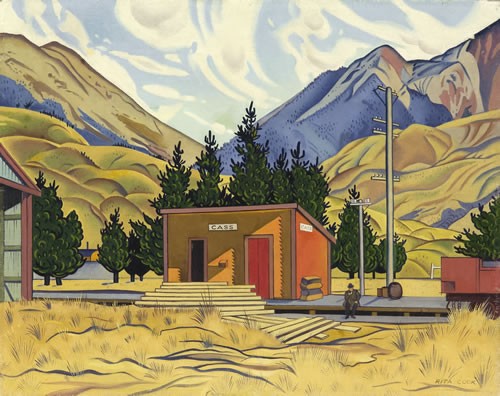
Cass, 1936, by Rita Angus.
Cass is one of the iconic images of 20th-century New Zealand painting. The work depicts Cass railway station in inland Canterbury, an area that Rita Angus (1908–70) visited in 1936 with fellow artist Louise Henderson (1902–94).
While the title is specific, the image is general. This location has been chosen for its typicality and stands for numerous small communities. The seated figure at right in the composition is dwarfed by the surrounding landscape and accentuates feelings of isolation and remoteness.
This work was finished in the studio after Angus had made studies outside. Each part was carefully planned to give order and clarity to the symbolic imagery. The work’s direct and unpretentious style is complemented by the strong ordering of the composition. Angus uses a pyramid form as its basis, with vertical divisions aiding the sense of structure.
Other elements typical of Angus’s style, and regionalism in general, include the flattening of form by use of flat, unmodulated colour, strong outlines, and the use of simplified colour and form.
When Cass was first exhibited in Christchurch in 1937, and later in Auckland in 1938, it received no comment in the press. At the time, Angus’s work seemed to be admired only by a discriminating group of friends. One of them, the musician Frederick Page, noticed how the artist drew with paint and likened her approach to that in Chinese art. In Angus’s Lake Wanaka, a 1938 watercolour, there is evidence of both the precise rhythms of Chinese landscape painting and the bright colours and bold outlines of Japanese woodcuts.

Community contributions